Art Lovers..Part 2 discussion
Picture of the Day
>
Artlovers Part 2 - Picture of the day - May 2021
date newest »
newest »
 newest »
newest »
From the Netherlands to my hometown is only a small step…
Henri de Braekeleer
(1840 – 1888)
Henri Jean Augustin de Braekeleer was a Belgian painter. He was born and died in Antwerp. He was trained in drawing by his father Ferdinand de Braekeleer, a well-known genre painter, and his uncle Jan August Hendrik Leys. Braekeleer entered the Royal Academy of Fine Arts (Antwerp) in 1854. Although he remained a student there until 1861, he publicly exhibited his paintings for the first time in 1858, when Reaper and Washerwoman (locations unknown) were shown at the Antwerp Salon. In 1863, he went to Germany and, in 1864, to the Netherlands, studying works by 16th- and 17th-century painters in both countries. The influence of Johannes Vermeer was especially important, seen in one of de Braekeleer's most characteristic subjects: a single person absorbed in a quiet activity, shown in an interior lit by a window.
https://en.wikipedia.org/wiki/Henri_d...

The Meal
Circa 1885
Oil on canvas
69,5 x 94,5 cm
KMSKA (Royal Museum of Fine Arts Antwerp)
https://www.kmska.be/en
Henri de Braekeleer
(1840 – 1888)
Henri Jean Augustin de Braekeleer was a Belgian painter. He was born and died in Antwerp. He was trained in drawing by his father Ferdinand de Braekeleer, a well-known genre painter, and his uncle Jan August Hendrik Leys. Braekeleer entered the Royal Academy of Fine Arts (Antwerp) in 1854. Although he remained a student there until 1861, he publicly exhibited his paintings for the first time in 1858, when Reaper and Washerwoman (locations unknown) were shown at the Antwerp Salon. In 1863, he went to Germany and, in 1864, to the Netherlands, studying works by 16th- and 17th-century painters in both countries. The influence of Johannes Vermeer was especially important, seen in one of de Braekeleer's most characteristic subjects: a single person absorbed in a quiet activity, shown in an interior lit by a window.
https://en.wikipedia.org/wiki/Henri_d...

The Meal
Circa 1885
Oil on canvas
69,5 x 94,5 cm
KMSKA (Royal Museum of Fine Arts Antwerp)
https://www.kmska.be/en
Paul Signac
( 1863 – 1935)
Paul Victor Jules Signac was a French Neo-Impressionist painter who, working with Georges Seurat, helped develop the Pointillist style.
https://en.wikipedia.org/wiki/Paul_Si...
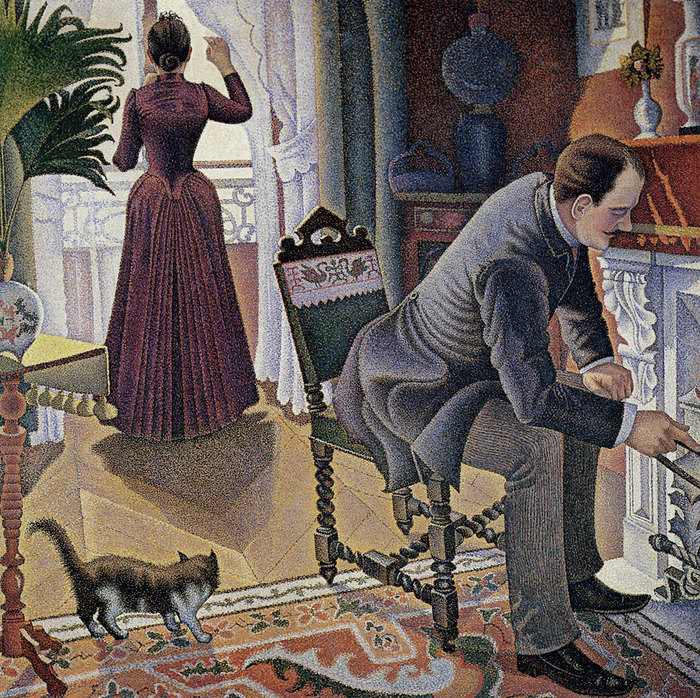
Sunday
between 1888 and 1890
Oil on canvas
150 x 150 cm
Private collection
( 1863 – 1935)
Paul Victor Jules Signac was a French Neo-Impressionist painter who, working with Georges Seurat, helped develop the Pointillist style.
https://en.wikipedia.org/wiki/Paul_Si...

Sunday
between 1888 and 1890
Oil on canvas
150 x 150 cm
Private collection
Albert Edelfelt
(1854 – 1905)
Albert Gustaf Aristides Edelfelt was a Finnish painter noted for his naturalistic style and Realist approach to art. He lived in the Grand Duchy of Finland and made Finnish culture visible abroad, before Finland gained full independence.
https://en.wikipedia.org/wiki/Albert_...
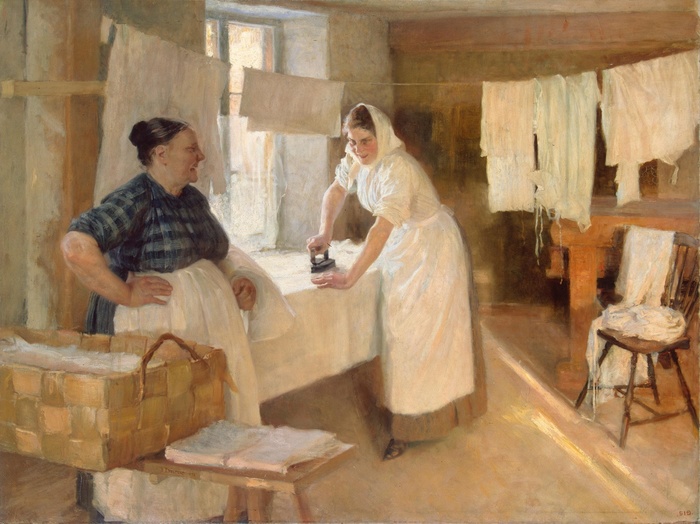
Laundresses
1893
Oil on canvas
97 x 128 cm
Private collection
Hermitage
https://www.hermitagemuseum.org/wps/p...
(1854 – 1905)
Albert Gustaf Aristides Edelfelt was a Finnish painter noted for his naturalistic style and Realist approach to art. He lived in the Grand Duchy of Finland and made Finnish culture visible abroad, before Finland gained full independence.
https://en.wikipedia.org/wiki/Albert_...

Laundresses
1893
Oil on canvas
97 x 128 cm
Private collection
Hermitage
https://www.hermitagemuseum.org/wps/p...
Last year in January I had as theme: “The artist’s Studio”,
https://www.goodreads.com/topic/show/...
The next one could have been included then, but I only came across a good pic some time later, so here it is now:
Jean-Baptiste van Moer
(1819 – 1884)
Jean-Baptiste Van Moer, was a Belgian artist, born in Brussels.
Wiki page only in French and Flemish:
https://fr.wikipedia.org/wiki/Jean-Ba...
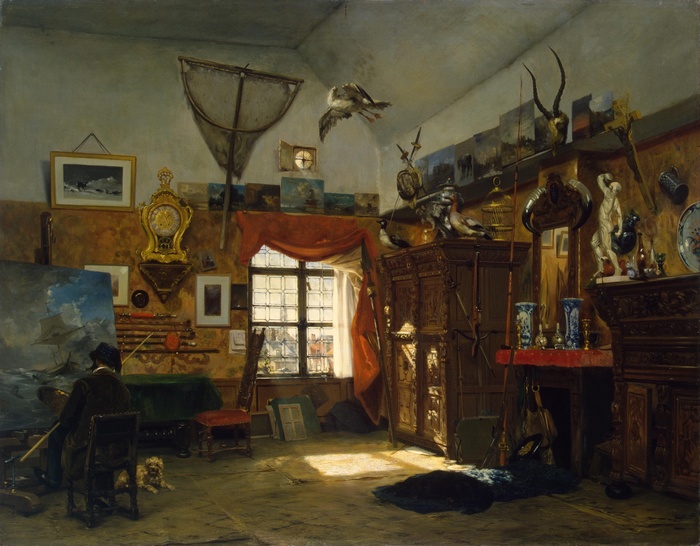
Painter's Studio
1854
Oil on canvas
80 x02 cm
Hermitage State Museum
https://www.hermitagemuseum.org/wps/p...
https://www.goodreads.com/topic/show/...
The next one could have been included then, but I only came across a good pic some time later, so here it is now:
Jean-Baptiste van Moer
(1819 – 1884)
Jean-Baptiste Van Moer, was a Belgian artist, born in Brussels.
Wiki page only in French and Flemish:
https://fr.wikipedia.org/wiki/Jean-Ba...

Painter's Studio
1854
Oil on canvas
80 x02 cm
Hermitage State Museum
https://www.hermitagemuseum.org/wps/p...
David Teniers the Younger
1610– 1690)
David Teniers the Younger or David Teniers II was a Flemish Baroque painter, printmaker, draughtsman, miniaturist painter, staffage painter, copyist and art curator. He was an extremely versatile artist known for his prolific output. He was an innovator in a wide range of genres such as history painting, genre painting, landscape painting, portrait and still life. He is now best remembered as the leading Flemish genre painter of his day. Teniers is particularly known for developing the peasant genre, the tavern scene, pictures of collections and scenes with alchemists and physicians.
https://en.wikipedia.org/wiki/David_T...

Monkeys in the Kitchen
1858
Oil on canvas transferred from wood
36 x 51 cm
Hermitage State Museum
https://www.hermitagemuseum.org/wps/p...
1610– 1690)
David Teniers the Younger or David Teniers II was a Flemish Baroque painter, printmaker, draughtsman, miniaturist painter, staffage painter, copyist and art curator. He was an extremely versatile artist known for his prolific output. He was an innovator in a wide range of genres such as history painting, genre painting, landscape painting, portrait and still life. He is now best remembered as the leading Flemish genre painter of his day. Teniers is particularly known for developing the peasant genre, the tavern scene, pictures of collections and scenes with alchemists and physicians.
https://en.wikipedia.org/wiki/David_T...

Monkeys in the Kitchen
1858
Oil on canvas transferred from wood
36 x 51 cm
Hermitage State Museum
https://www.hermitagemuseum.org/wps/p...
Adolphe Ladurner
(1798 – 1856)
Adolf Ignatievich Ladurner was born into the family of the composer and pianist Ignacy Ladürner [fr], a native of Tyrol. He studied painting with Horace Vernet], and then lived and worked in Paris, creating works in the field of battle painting (parades, scenes of military operations). He exhibited his works twice in the Salon (in 1824 the painting "The Battle of Mataro" and in 1827 - "The main headquarters of the royal lancers" .
In 1830 he moved to St. Petersburg, where he soon gained the favor of Emperor Nicholas I and painted for him images of military parades, divorces, camp scenes, uniforms of various parts of the Russian army
Translated from the Russian Wikipage
https://ru.wikipedia.org/wiki/%D0%9B%...
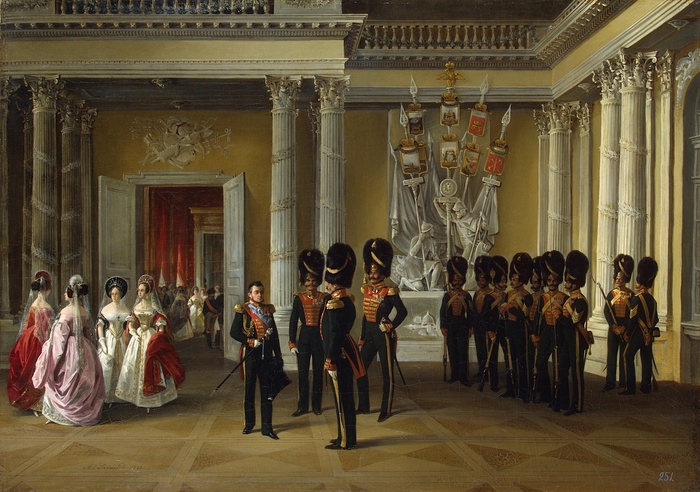
Armorial Hall of the Winter Palace
1838
Oil on canvas
69 x 96 cm
Hermitage State Museum
https://www.hermitagemuseum.org/wps/p...
(1798 – 1856)
Adolf Ignatievich Ladurner was born into the family of the composer and pianist Ignacy Ladürner [fr], a native of Tyrol. He studied painting with Horace Vernet], and then lived and worked in Paris, creating works in the field of battle painting (parades, scenes of military operations). He exhibited his works twice in the Salon (in 1824 the painting "The Battle of Mataro" and in 1827 - "The main headquarters of the royal lancers" .
In 1830 he moved to St. Petersburg, where he soon gained the favor of Emperor Nicholas I and painted for him images of military parades, divorces, camp scenes, uniforms of various parts of the Russian army
Translated from the Russian Wikipage
https://ru.wikipedia.org/wiki/%D0%9B%...

Armorial Hall of the Winter Palace
1838
Oil on canvas
69 x 96 cm
Hermitage State Museum
https://www.hermitagemuseum.org/wps/p...
Eduard von Grützner
(1846 - 1925)
Eduard Theodor Ritter von Grützner (May 26, 1846 – April 2, 1925) was a German painter and professor of art. He was especially noted for his genre paintings of monks. He also repeatedly portrayed Falstaff.
https://en.wikipedia.org/wiki/Eduard_...
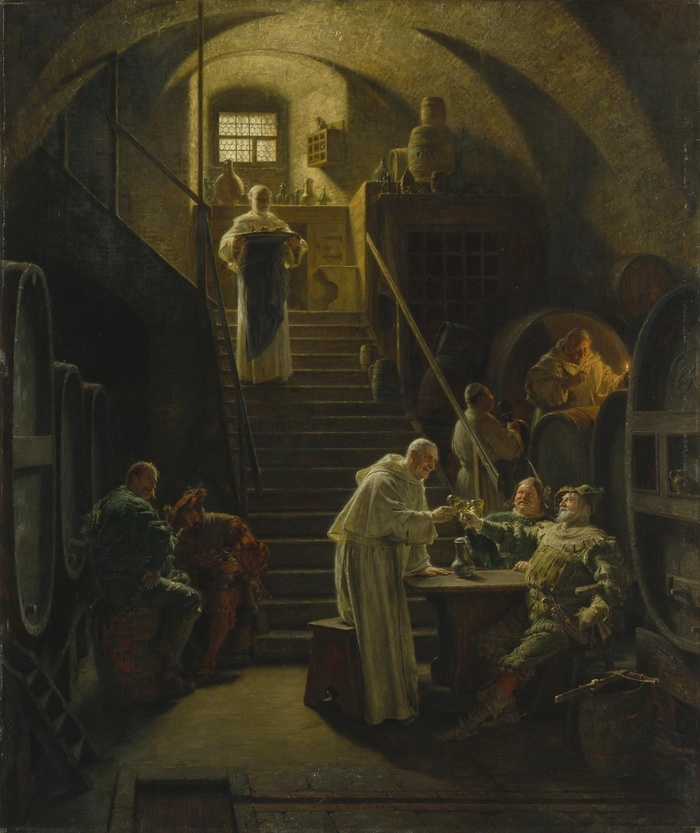
Visiting monks
1903
Oil on mahogany panel
100,5 x 89,5 cm
Hermitage State Museum
https://www.hermitagemuseum.org/wps/p...
(1846 - 1925)
Eduard Theodor Ritter von Grützner (May 26, 1846 – April 2, 1925) was a German painter and professor of art. He was especially noted for his genre paintings of monks. He also repeatedly portrayed Falstaff.
https://en.wikipedia.org/wiki/Eduard_...

Visiting monks
1903
Oil on mahogany panel
100,5 x 89,5 cm
Hermitage State Museum
https://www.hermitagemuseum.org/wps/p...
François Marius Granet
(1775 - 18495)
François Marius Granet was a French painter, born on 17 December 1775 in Aix-en-Provence; his father was a small builder. As a boy his strong desires led his parents to place him, after some preliminary teaching from a passing Italian artist, in a free school of art directed by M. Constantin, a landscape painter of some reputation. In 1793, Granet followed the volunteers of Aix to the siege of Toulon, where he obtained employment as a decorator in the arsenal.
https://en.wikipedia.org/wiki/Françoi...
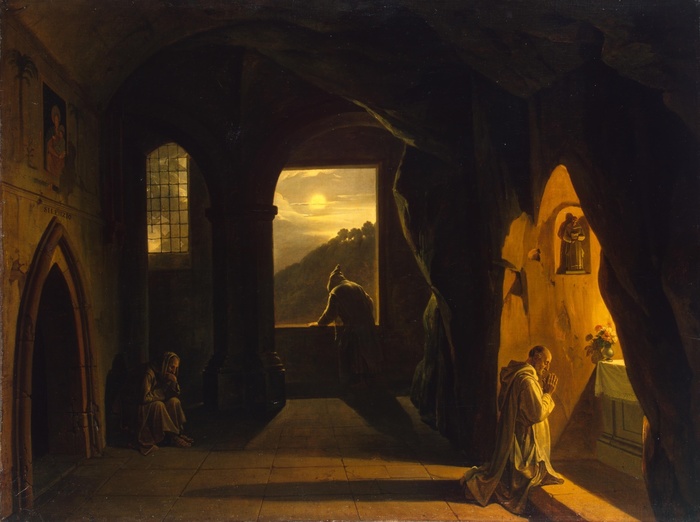
Monks in a Cave
First half of the 19th century
Oil on canvas
75 x 100 cm
Hermitage State Museum
https://www.hermitagemuseum.org/wps/p...
(1775 - 18495)
François Marius Granet was a French painter, born on 17 December 1775 in Aix-en-Provence; his father was a small builder. As a boy his strong desires led his parents to place him, after some preliminary teaching from a passing Italian artist, in a free school of art directed by M. Constantin, a landscape painter of some reputation. In 1793, Granet followed the volunteers of Aix to the siege of Toulon, where he obtained employment as a decorator in the arsenal.
https://en.wikipedia.org/wiki/Françoi...

Monks in a Cave
First half of the 19th century
Oil on canvas
75 x 100 cm
Hermitage State Museum
https://www.hermitagemuseum.org/wps/p...
Norman Wilkinson
(1878 – 1971)
Norman Wilkinson CBE RI was a British artist who usually worked in oils, watercolours and drypoint. He was primarily a marine painter, but also an illustrator, poster artist, and wartime camoufleur. Wilkinson invented dazzle painting to protect merchant shipping during the First World War.
https://en.wikipedia.org/wiki/Norman_...
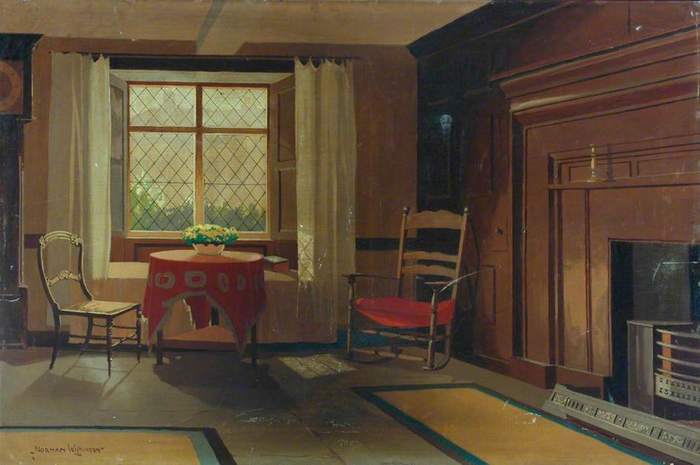
Dove Cottage, Grasmere (London, Midland and Scottish Railway poster artwork)
1823
Oil on canvas
81,7 x 120.1 cm
National Railway Museum
York
(1878 – 1971)
Norman Wilkinson CBE RI was a British artist who usually worked in oils, watercolours and drypoint. He was primarily a marine painter, but also an illustrator, poster artist, and wartime camoufleur. Wilkinson invented dazzle painting to protect merchant shipping during the First World War.
https://en.wikipedia.org/wiki/Norman_...

Dove Cottage, Grasmere (London, Midland and Scottish Railway poster artwork)
1823
Oil on canvas
81,7 x 120.1 cm
National Railway Museum
York
Edward Harrison Richardson
(1881 – 1952)
Edward Harrison Richardson was a British artist.
No Wikipedia page.
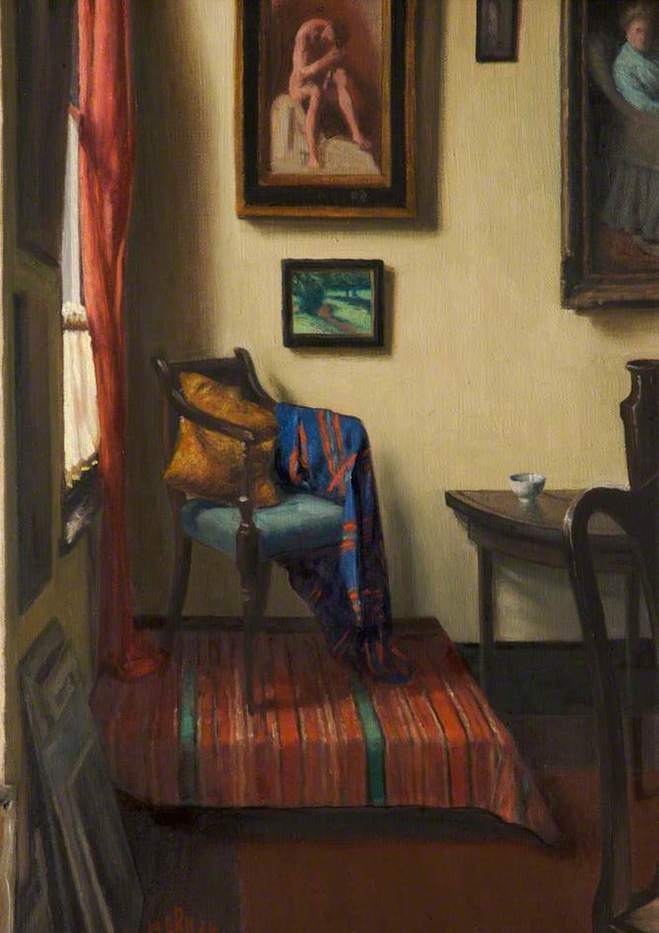
A corner of my studio
1924
Oil on canvas
37,5 x 32 cm
Stockport Heritage Services
https://artuk.org/discover/artworks/a...
(1881 – 1952)
Edward Harrison Richardson was a British artist.
No Wikipedia page.

A corner of my studio
1924
Oil on canvas
37,5 x 32 cm
Stockport Heritage Services
https://artuk.org/discover/artworks/a...
Pieter Janssens Elinga
(1623 – 1682)
Pieter Janssens Elinga was a Dutch Golden Age painter, mainly of domestic interior scenes with a strong emphasis on the rectangular geometrical elements of windows, floor tiling paintings, and other elements, and a few genre figures. He also painted still lifes.
https://en.wikipedia.org/wiki/Pieter_...
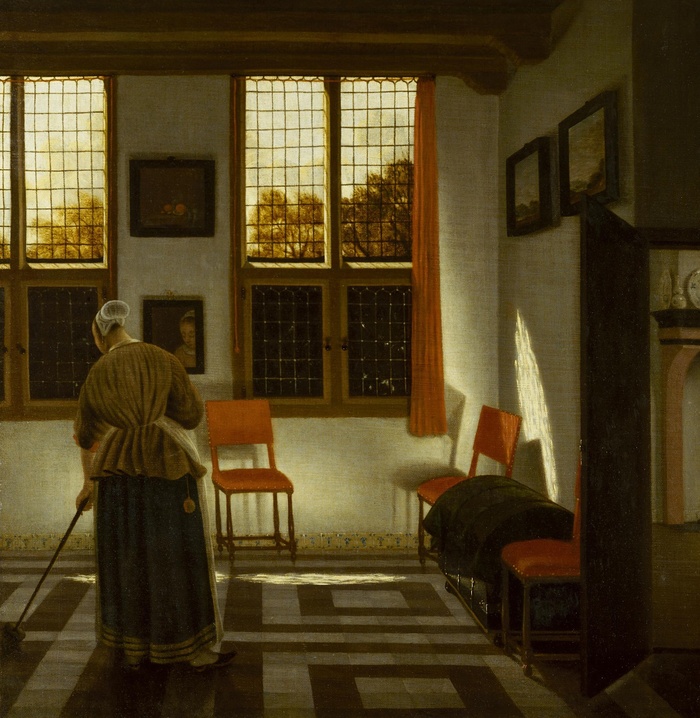
Room in a Dutch House
Between 1668 and 1672
Oil on ca5974,14 cm
Hermitage Museum
https://www.hermitagemuseum.org/wps/p...
(1623 – 1682)
Pieter Janssens Elinga was a Dutch Golden Age painter, mainly of domestic interior scenes with a strong emphasis on the rectangular geometrical elements of windows, floor tiling paintings, and other elements, and a few genre figures. He also painted still lifes.
https://en.wikipedia.org/wiki/Pieter_...

Room in a Dutch House
Between 1668 and 1672
Oil on ca5974,14 cm
Hermitage Museum
https://www.hermitagemuseum.org/wps/p...
Jules Victor Génisson
(1805 - 1860)
Jules Victor Génisson was a Belgian painter, chiefly known for his architectural painting.
https://en.wikipedia.org/wiki/Jules_V...

Interior of the Cathedral of Amiens
1842
Oil on canvas
110.5 x 115 cm
Pinacoteca do Estado de São Paulo
(1805 - 1860)
Jules Victor Génisson was a Belgian painter, chiefly known for his architectural painting.
https://en.wikipedia.org/wiki/Jules_V...

Interior of the Cathedral of Amiens
1842
Oil on canvas
110.5 x 115 cm
Pinacoteca do Estado de São Paulo
Jan Geeraerts
(1814 - 1890)
Jan Geeraerts was a Belgian painter. He was a student at the Academy of Antwerp. He mainly painted interiors of churches and picturesque old buildings. He also painted genre scenes and religious subjects. The church interior was a genre that was practiced on a regular basis only by few other artists in Belgium: Jules-Victor Genisson, Joseph-Chrétien Nicolié, André-Joseph Minguet, Bernard Neyt and Joseph Maswiens. His church interiors are often those of Antwerp churches. But there is also a painting of the interior of the Nieuwe Kerk in Delft with a view of the mausoleum of Willem the Silent. He participated in the Salons in Antwerp, Brussels and Ghent. These were large group exhibitions of living artists, at the time about the only opportunities for a visual artist to present himself to a wide audience.
This is a translation of the Flemish Wiki page:
https://nl.wikipedia.org/wiki/Jan_Gee...
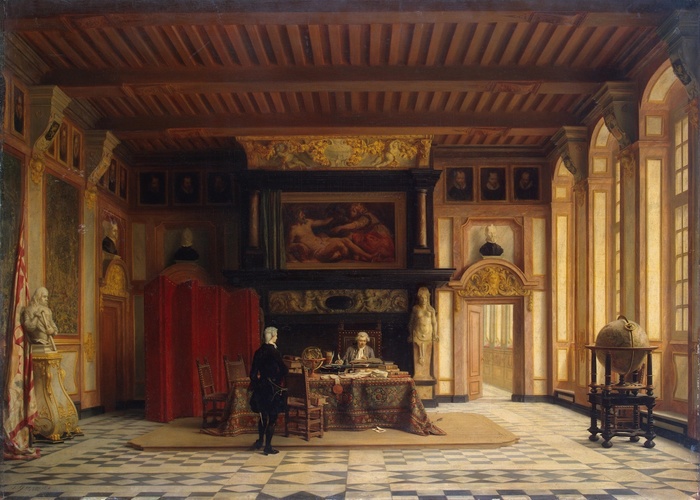
Hall of Estates at the City Council in Antwerp
1856
80 x 109 cm
Hermitage museum
https://www.hermitagemuseum.org/wps/p...
(1814 - 1890)
Jan Geeraerts was a Belgian painter. He was a student at the Academy of Antwerp. He mainly painted interiors of churches and picturesque old buildings. He also painted genre scenes and religious subjects. The church interior was a genre that was practiced on a regular basis only by few other artists in Belgium: Jules-Victor Genisson, Joseph-Chrétien Nicolié, André-Joseph Minguet, Bernard Neyt and Joseph Maswiens. His church interiors are often those of Antwerp churches. But there is also a painting of the interior of the Nieuwe Kerk in Delft with a view of the mausoleum of Willem the Silent. He participated in the Salons in Antwerp, Brussels and Ghent. These were large group exhibitions of living artists, at the time about the only opportunities for a visual artist to present himself to a wide audience.
This is a translation of the Flemish Wiki page:
https://nl.wikipedia.org/wiki/Jan_Gee...

Hall of Estates at the City Council in Antwerp
1856
80 x 109 cm
Hermitage museum
https://www.hermitagemuseum.org/wps/p...
Bartholomeus van Bassen
(1590– 1652)
Bartholomeus Corneliszoon van Bassen was a Dutch Golden Age painter and architect. Van Bassen was the illegitimate son of Cornelis van Bassen and the grandson of Bartholt Ernst van Bassen, who both lived and died in The Hague. Little is known of his early life, but according to the Netherlands Institute for Art History he became a member of the Delft Guild of St. Luke in 1613. In 1622 he moved to The Hague, where he became a member of The Hague Guild of St. Luke two years later and where he became dean in 1627 and headman in 1636 and 1640. He is known for his architectural works, sometimes with staffage by the painters Anthonie Palamedesz, Esaias van de Velde, and Jan Martszen de Jonge.
https://en.wikipedia.org/wiki/Barthol...
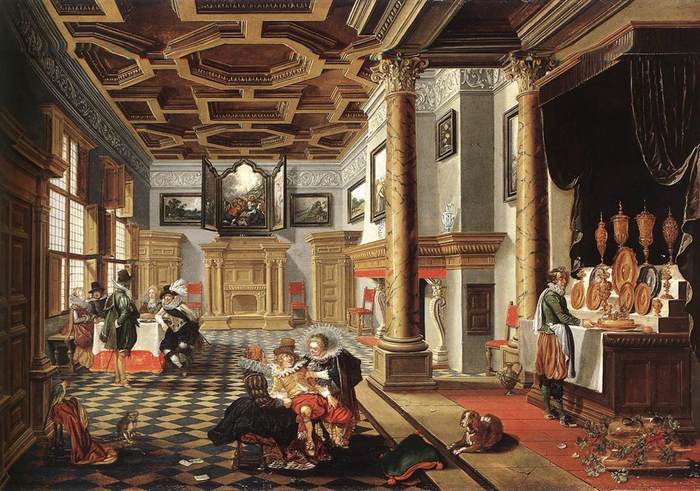
Renaissance Interior with Banqueters.
Between 1618 and 1620
Oil on panel
57,5 x 87cm
North Carolina Museum of Art
https://ncartmuseum.org/
(1590– 1652)
Bartholomeus Corneliszoon van Bassen was a Dutch Golden Age painter and architect. Van Bassen was the illegitimate son of Cornelis van Bassen and the grandson of Bartholt Ernst van Bassen, who both lived and died in The Hague. Little is known of his early life, but according to the Netherlands Institute for Art History he became a member of the Delft Guild of St. Luke in 1613. In 1622 he moved to The Hague, where he became a member of The Hague Guild of St. Luke two years later and where he became dean in 1627 and headman in 1636 and 1640. He is known for his architectural works, sometimes with staffage by the painters Anthonie Palamedesz, Esaias van de Velde, and Jan Martszen de Jonge.
https://en.wikipedia.org/wiki/Barthol...

Renaissance Interior with Banqueters.
Between 1618 and 1620
Oil on panel
57,5 x 87cm
North Carolina Museum of Art
https://ncartmuseum.org/
Stanhope Forbes
(1857 – 1947)
Stanhope Alexander Forbes RA (18 November 1857 – 2 March 1947) was a British artist and a founding member of the influential Newlyn school of painters. He was often called 'the father of the Newlyn School'.
https://en.wikipedia.org/wiki/Stanhop...
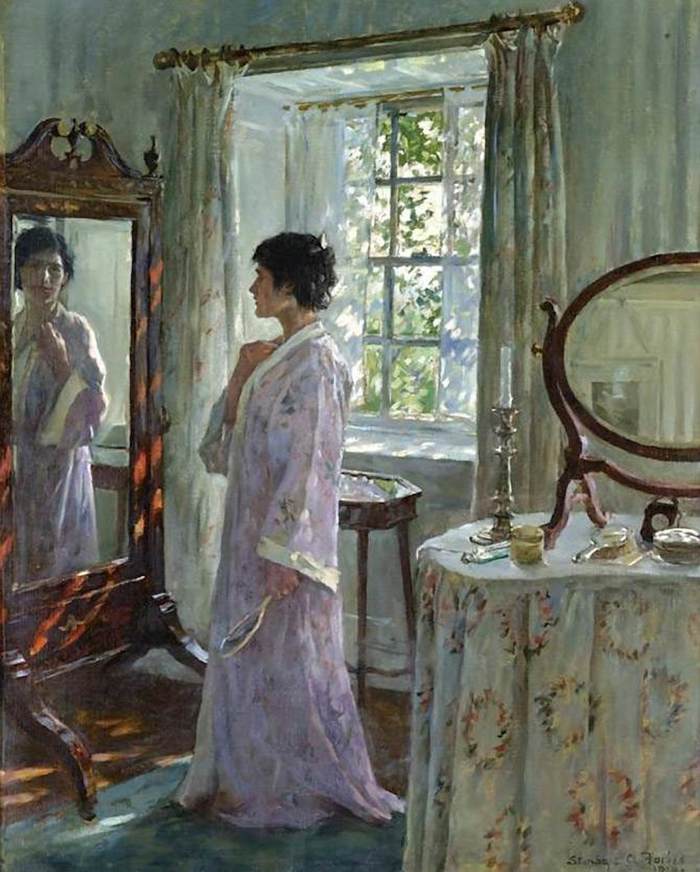
THROUGH THE LOOKING GLASS
1914
Oil on canvas
78 x 63cm
Private collection
Sold by Sotheby’s London, 14 December 2006, for 176.000£
http://www.sothebys.com/en/auctions/e...
(1857 – 1947)
Stanhope Alexander Forbes RA (18 November 1857 – 2 March 1947) was a British artist and a founding member of the influential Newlyn school of painters. He was often called 'the father of the Newlyn School'.
https://en.wikipedia.org/wiki/Stanhop...

THROUGH THE LOOKING GLASS
1914
Oil on canvas
78 x 63cm
Private collection
Sold by Sotheby’s London, 14 December 2006, for 176.000£
http://www.sothebys.com/en/auctions/e...
William Orpen
(1878 – 1931)
Major Sir William Newenham Montague Orpen, KBE, RA, RHA was an Irish artist who worked mainly in London. Orpen was a fine draughtsman and a popular, commercially successful painter of portraits for the well-to-do in Edwardian society, though many of his most striking paintings are self-portraits.
https://en.wikipedia.org/wiki/William...

Window in London Street,
1901
Oil on Canvas,
103 x 87 cm
National Gallery of Ireland
Dublin City, Ireland
http://onlinecollection.nationalgalle...
(1878 – 1931)
Major Sir William Newenham Montague Orpen, KBE, RA, RHA was an Irish artist who worked mainly in London. Orpen was a fine draughtsman and a popular, commercially successful painter of portraits for the well-to-do in Edwardian society, though many of his most striking paintings are self-portraits.
https://en.wikipedia.org/wiki/William...

Window in London Street,
1901
Oil on Canvas,
103 x 87 cm
National Gallery of Ireland
Dublin City, Ireland
http://onlinecollection.nationalgalle...
James Ensor
(1860 – 1949)
James Sidney Edouard, Baron Ensor was a Belgian painter and printmaker, an important influence on expressionism and surrealism who lived in Ostend for most of his life. He was associated with the artistic group Les XX.
https://en.wikipedia.org/wiki/James_E...

Russian Music
1881
Oil on canvas
133 x 110
Royal Museums of Fine Arts of Belgium, Brussels
https://www.fine-arts-museum.be/en
(1860 – 1949)
James Sidney Edouard, Baron Ensor was a Belgian painter and printmaker, an important influence on expressionism and surrealism who lived in Ostend for most of his life. He was associated with the artistic group Les XX.
https://en.wikipedia.org/wiki/James_E...

Russian Music
1881
Oil on canvas
133 x 110
Royal Museums of Fine Arts of Belgium, Brussels
https://www.fine-arts-museum.be/en
Anna Ancher
(1859 – 1935)
Anna Ancher was a Danish artist associated with the Skagen Painters, an artist colony on the northern point of Jylland, Denmark. She is considered to be one of Denmark's greatest visual artists.
https://en.wikipedia.org/wiki/Anna_An...
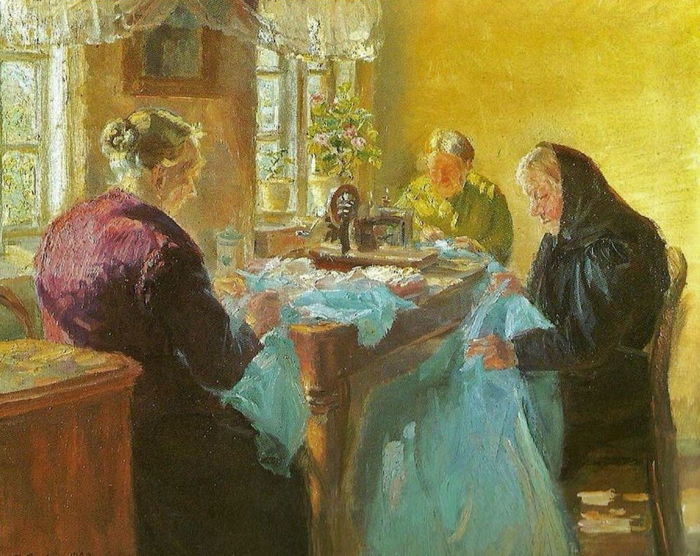
Three old women sewing a blue dress for a fancy dress ball
1820
Oil on canvas
54.8 x 68,7
https://skagenskunstmuseer.dk/
(1859 – 1935)
Anna Ancher was a Danish artist associated with the Skagen Painters, an artist colony on the northern point of Jylland, Denmark. She is considered to be one of Denmark's greatest visual artists.
https://en.wikipedia.org/wiki/Anna_An...

Three old women sewing a blue dress for a fancy dress ball
1820
Oil on canvas
54.8 x 68,7
https://skagenskunstmuseer.dk/
Jozef Geirnaert
(1790 – 1859)
Jozef Geirnaert, also known as Jozef Lodewijk Geirnaert, Théodore-Joseph-Louis Geirnaert and Joseph Louis Geirnaert, was a 19th-century painter and draughtsman from Belgium. He is known for his genre scenes, portraits as well as his historical, religious and mythological paintings. He was first influenced by the Neoclassical style of Jacques-Louis David and later by the version of Romanticism that was in vogue in Belgium from the 1830s.
https://en.wikipedia.org/wiki/Jozef_G...
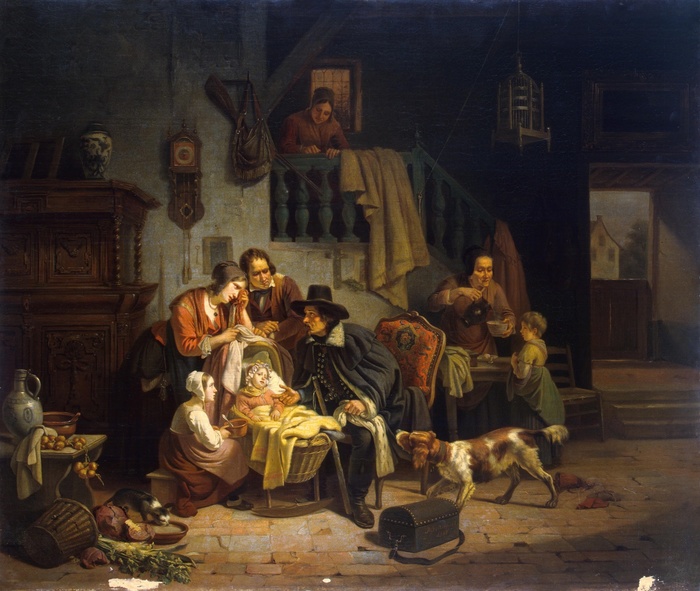
Hungarian Doctor
1836
Oil on canvas
89,5 x 107
Hermitage Museum
https://www.hermitagemuseum.org/wps/p...
(1790 – 1859)
Jozef Geirnaert, also known as Jozef Lodewijk Geirnaert, Théodore-Joseph-Louis Geirnaert and Joseph Louis Geirnaert, was a 19th-century painter and draughtsman from Belgium. He is known for his genre scenes, portraits as well as his historical, religious and mythological paintings. He was first influenced by the Neoclassical style of Jacques-Louis David and later by the version of Romanticism that was in vogue in Belgium from the 1830s.
https://en.wikipedia.org/wiki/Jozef_G...

Hungarian Doctor
1836
Oil on canvas
89,5 x 107
Hermitage Museum
https://www.hermitagemuseum.org/wps/p...
Friedrich Eduard Meyerheim
(1808, 1879)
Friedrich Eduard Meyerhei was a German painter. He received his first training from his father, Karl Friedrich Meyerheim (1780-1837), a decorative painter. After further studies with the architect and painter Johann Adam Breysig, he went to Berlin in 1830 and enrolled at the Prussian Academy of Art. His teachers there were Eduard Daege and Johann Gottfried Niedlich.
After graduating, he wandered about with his friend, the future Prussian court architect Heinrich Strack, and produced numerous architectural drawings, primarily of churches and older Backsteingotik brick buildings. His first original work, the Schützenfest westfälischer Bauern (Westphalian Peasants Hunting Party) was painted in 1836 and bought by Joachim Heinrich Wilhelm Wagener, the Swedish-Norwegian Consul, from whose estate it entered the National Gallery (Berlin).
Under the influence of the Düsseldorf school of painting, he spent the years 1833-1841 producing works in the Romantic genre style. After that, he devoted himself exclusively to portrayals of bourgeois and peasant life, focusing on Westphalia, Thuringia, and Hesse. His work is characterized by enamel-like coloring. By 1855, he was a Regius Professor and a member of the Academies in Berlin, Dresden and Munich.
In 1836, he married Karoline Drake, the sister of sculptor Friedrich Drake. In 1870, he was afflicted by a debilitating nervous disorder that periodically prevented him from painting and eventually led to his death.
https://en.wikipedia.org/wiki/Friedri...

Guten Morgen, lieber Vater (Good Morning, Dear Father or Scene by the Window)
1858
Oil on canvas
49 x 40
Hermitage Museum
https://www.hermitagemuseum.org/wps/p...
(1808, 1879)
Friedrich Eduard Meyerhei was a German painter. He received his first training from his father, Karl Friedrich Meyerheim (1780-1837), a decorative painter. After further studies with the architect and painter Johann Adam Breysig, he went to Berlin in 1830 and enrolled at the Prussian Academy of Art. His teachers there were Eduard Daege and Johann Gottfried Niedlich.
After graduating, he wandered about with his friend, the future Prussian court architect Heinrich Strack, and produced numerous architectural drawings, primarily of churches and older Backsteingotik brick buildings. His first original work, the Schützenfest westfälischer Bauern (Westphalian Peasants Hunting Party) was painted in 1836 and bought by Joachim Heinrich Wilhelm Wagener, the Swedish-Norwegian Consul, from whose estate it entered the National Gallery (Berlin).
Under the influence of the Düsseldorf school of painting, he spent the years 1833-1841 producing works in the Romantic genre style. After that, he devoted himself exclusively to portrayals of bourgeois and peasant life, focusing on Westphalia, Thuringia, and Hesse. His work is characterized by enamel-like coloring. By 1855, he was a Regius Professor and a member of the Academies in Berlin, Dresden and Munich.
In 1836, he married Karoline Drake, the sister of sculptor Friedrich Drake. In 1870, he was afflicted by a debilitating nervous disorder that periodically prevented him from painting and eventually led to his death.
https://en.wikipedia.org/wiki/Friedri...

Guten Morgen, lieber Vater (Good Morning, Dear Father or Scene by the Window)
1858
Oil on canvas
49 x 40
Hermitage Museum
https://www.hermitagemuseum.org/wps/p...
Ferdinand de Braekeleer
(1792– 1883)
Ferdinand de Braekeleer sometimes spelled as Ferdinand de Braeckeleer, was a Flemish painter. He is known for his historical paintings and is called 'the Elder' to distinguish him from his son with the same name (Ferdinand de Braekeleer the Younger), who was also a painter.
https://en.wikipedia.org/wiki/Ferdina...
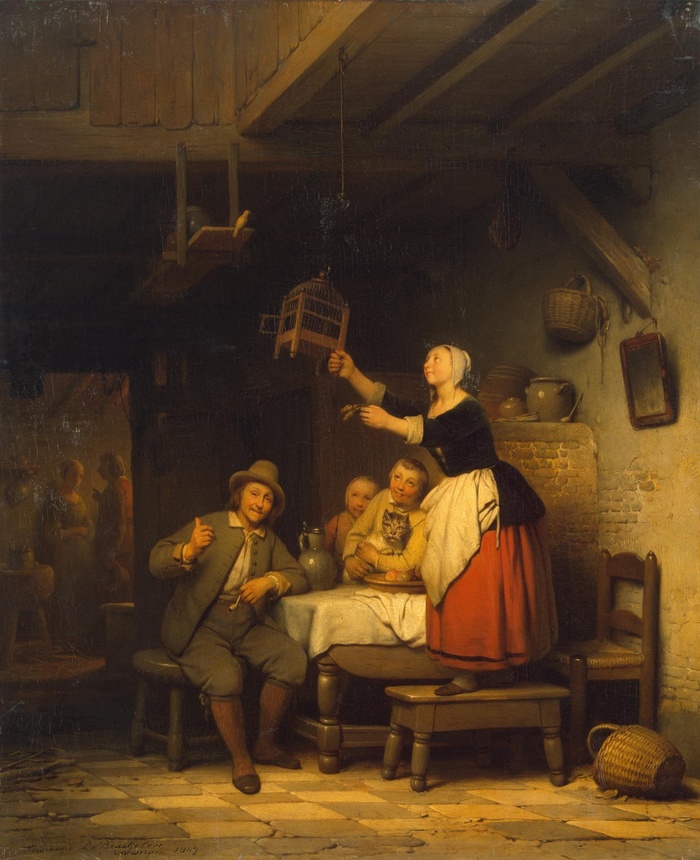
The bird has flown
1849
44 x 36,5 cm.
Hermitage Museum
https://www.hermitagemuseum.org/wps/p...
(1792– 1883)
Ferdinand de Braekeleer sometimes spelled as Ferdinand de Braeckeleer, was a Flemish painter. He is known for his historical paintings and is called 'the Elder' to distinguish him from his son with the same name (Ferdinand de Braekeleer the Younger), who was also a painter.
https://en.wikipedia.org/wiki/Ferdina...

The bird has flown
1849
44 x 36,5 cm.
Hermitage Museum
https://www.hermitagemuseum.org/wps/p...
Félix Vallotton
(1865 - 1925)
Félix Edouard Vallotton was a Swiss and French painter and printmaker associated with the group of artists known as Les Nabis. He was an important figure in the development of the modern woodcut. He painted portraits, landscapes, nudes, still lifes, and other subjects in an unemotional, realistic style.
https://en.wikipedia.org/wiki/Félix_V...

Intérieur
11904
Oil on cardboard
61,5 x 56 cm
Hermitage
https://www.hermitagemuseum.org/wps/p...
(1865 - 1925)
Félix Edouard Vallotton was a Swiss and French painter and printmaker associated with the group of artists known as Les Nabis. He was an important figure in the development of the modern woodcut. He painted portraits, landscapes, nudes, still lifes, and other subjects in an unemotional, realistic style.
https://en.wikipedia.org/wiki/Félix_V...

Intérieur
11904
Oil on cardboard
61,5 x 56 cm
Hermitage
https://www.hermitagemuseum.org/wps/p...
Étienne Moreau-Nélaton
(1859 – 1927)
Adolphe Étienne Auguste Moreau-Nélaton was a French painter, art collector and art historian. His large collection is today held in its entirety by French national museums.
https://en.wikipedia.org/wiki/étienne...
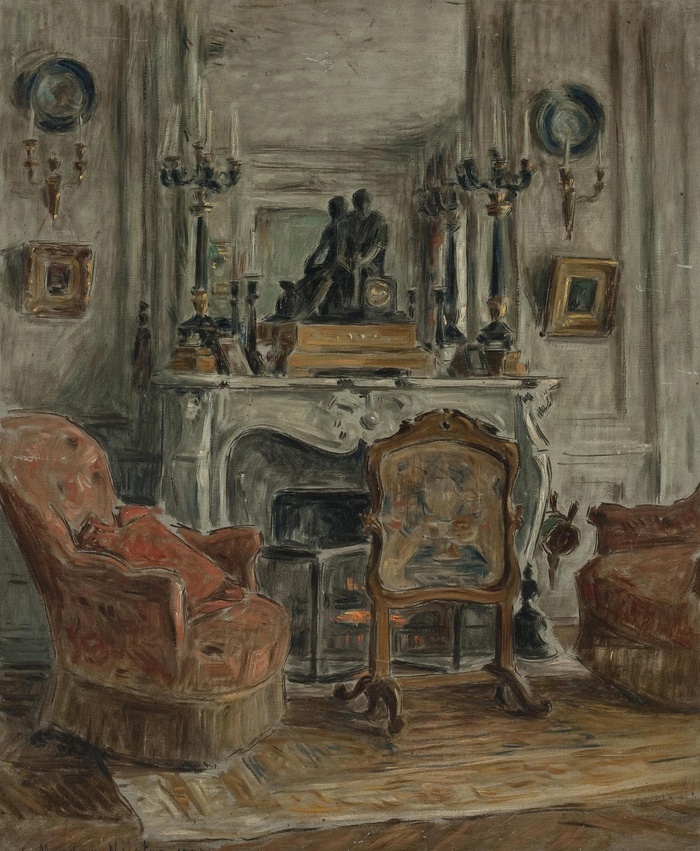
1900
Oil on Canvas
60 x 60 cm
Hermitage Museum
https://hermitagemuseum.org/wps/porta...
(1859 – 1927)
Adolphe Étienne Auguste Moreau-Nélaton was a French painter, art collector and art historian. His large collection is today held in its entirety by French national museums.
https://en.wikipedia.org/wiki/étienne...

1900
Oil on Canvas
60 x 60 cm
Hermitage Museum
https://hermitagemuseum.org/wps/porta...
Thomas Eakins
(1844 – 1916)
Thomas Cowperthwait Eakins was an American realist painter, photographer, sculptor, and fine arts educator. He is widely acknowledged to be one of the most important American artists.
https://en.wikipedia.org/wiki/Thomas_...
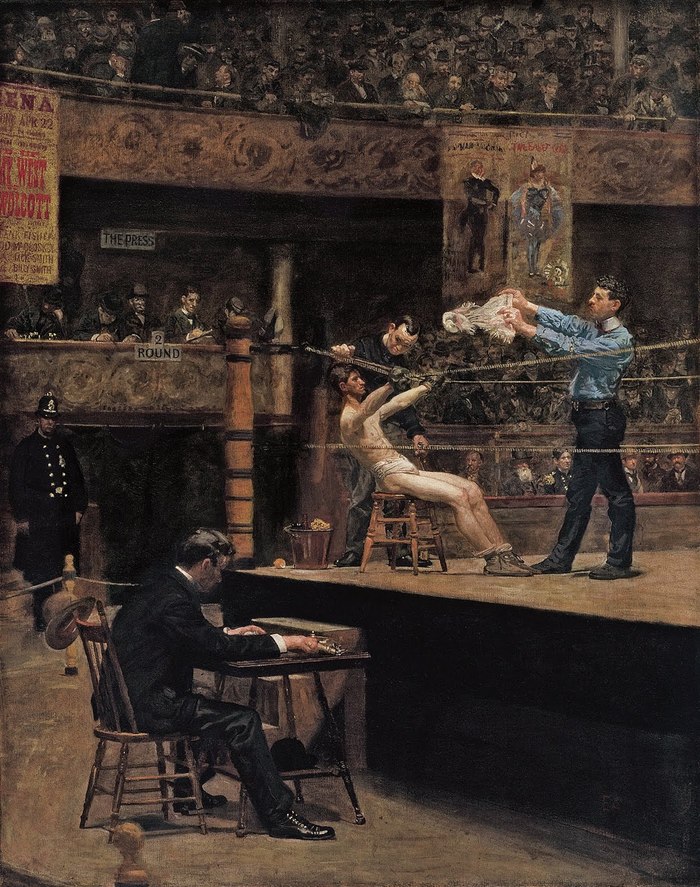
Between Rounds
1898-1899
Oil on canvas
127 x 101 cm
Philadelphia Museum of Art
https://www.philamuseum.org/collectio...
(1844 – 1916)
Thomas Cowperthwait Eakins was an American realist painter, photographer, sculptor, and fine arts educator. He is widely acknowledged to be one of the most important American artists.
https://en.wikipedia.org/wiki/Thomas_...

Between Rounds
1898-1899
Oil on canvas
127 x 101 cm
Philadelphia Museum of Art
https://www.philamuseum.org/collectio...
John Stanton Ward
(1917– 2007)
John Stanton Ward CBE was an English portrait artist, landscape painter and illustrator. His subjects included British royalty and celebrities.
https://en.wikipedia.org/wiki/John_St...
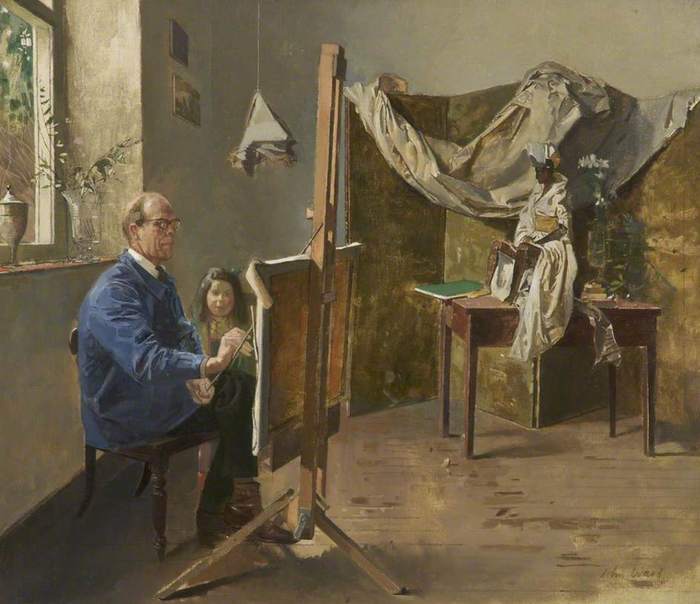
The Still Life Painter
1962
Oil on Canvas
49.5 x 60 cm
Bury Art Museum
https://buryartmuseum.co.uk/
(1917– 2007)
John Stanton Ward CBE was an English portrait artist, landscape painter and illustrator. His subjects included British royalty and celebrities.
https://en.wikipedia.org/wiki/John_St...

The Still Life Painter
1962
Oil on Canvas
49.5 x 60 cm
Bury Art Museum
https://buryartmuseum.co.uk/
Henry Herbert La Thangue
(1859 – 1929)
Henry Herbert La Thangue RA (19 January 1859 – 21 December 1929) was an English realist rural landscape painter associated with the Newlyn School.
https://en.wikipedia.org/wiki/Henry_H...

The Connoisseur
1887
Oil on canvas
114 x 160 cm
Cartwright Hall, Bradford
(1859 – 1929)
Henry Herbert La Thangue RA (19 January 1859 – 21 December 1929) was an English realist rural landscape painter associated with the Newlyn School.
https://en.wikipedia.org/wiki/Henry_H...

The Connoisseur
1887
Oil on canvas
114 x 160 cm
Cartwright Hall, Bradford
Gerald Gardiner
(1902-1959)
Gerald Gardiner was a landscape painter in oil, and teacher. Born in London, he studied at Beckenham School of Art, under Percy Jowett, 1919–23, then at the Royal College of Art, 1923–7. Exhibited RA, NEAC, RSA and Cooling Galleries. During World War II he completed wall decorations for the Cheltenham Services Club, a year later illustrating Fred Kitchen’s book Jesse and His Friends. Work in several public collections. Gardiner’s landscapes are notable for their translucent colour. Lived in Stroud, Gloucestershire.
https://artuk.org/discover/artists/ga...
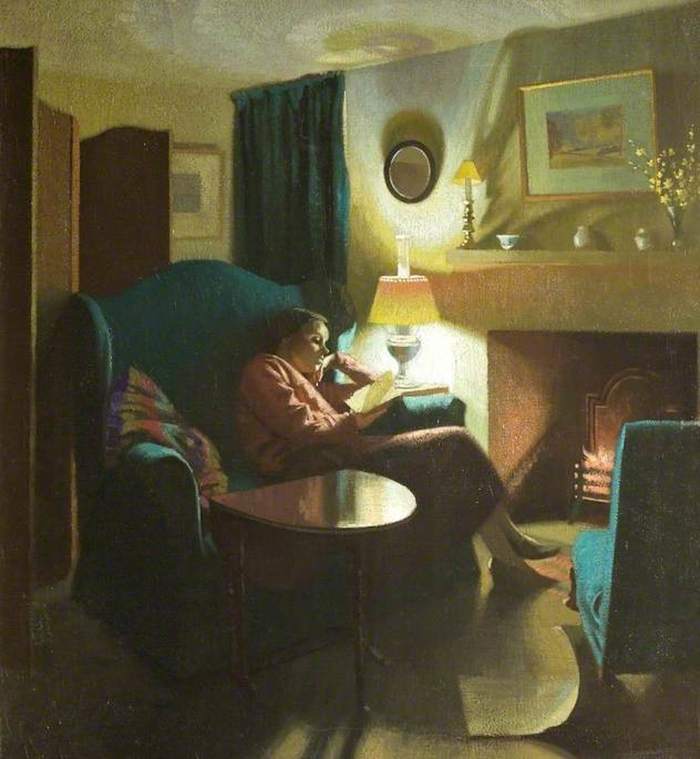
The Artist's Wife, Evelyn, Seated, Reading
C.1935
Oil on canvas
69,7x 64,3 cm
The Wilson, Cheltenham
https://www.cheltenhammuseum.org.uk/
(1902-1959)
Gerald Gardiner was a landscape painter in oil, and teacher. Born in London, he studied at Beckenham School of Art, under Percy Jowett, 1919–23, then at the Royal College of Art, 1923–7. Exhibited RA, NEAC, RSA and Cooling Galleries. During World War II he completed wall decorations for the Cheltenham Services Club, a year later illustrating Fred Kitchen’s book Jesse and His Friends. Work in several public collections. Gardiner’s landscapes are notable for their translucent colour. Lived in Stroud, Gloucestershire.
https://artuk.org/discover/artists/ga...

The Artist's Wife, Evelyn, Seated, Reading
C.1935
Oil on canvas
69,7x 64,3 cm
The Wilson, Cheltenham
https://www.cheltenhammuseum.org.uk/
Evelyn Dunbar
(1906 – 1960)
Evelyn Mary Dunbar was a British artist, illustrator and teacher. She is notable for recording women's contributions to World War II on the United Kingdom home front, particularly the work of the Women's Land Army. She was the only woman working for the War Artists' Advisory Committee on a full-time salaried basis. Dunbar had a deep devotion to nature and a particular affection for the landscape of Kent. Dunbar was modest regarding her achievements and outside of the post-war mainstream art world which has led to some neglect of her work until recent years. She painted murals at Brockley County Secondary School, and was a member of the Society of Mural Painters. After the war she painted portraits, allegorical pictures and especially landscapes. She attempted a return to mural painting in 1958 with a commission at Bletchley Park Teacher Training College, but was unable to fulfil the original specification.
https://en.wikipedia.org/wiki/Evelyn_...
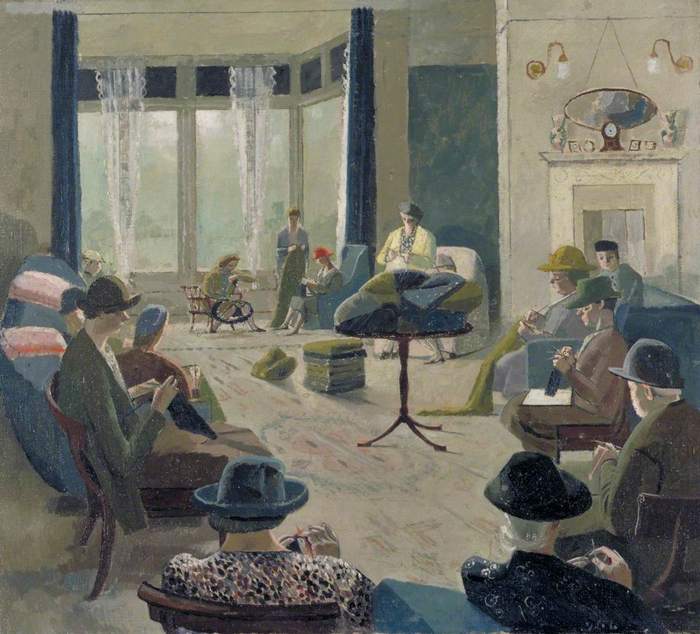
A Knitting Party
1940
Oil on canvas
45,7 x 50,8 cm
Imperial War Museum London
https://artuk.org/discover/artworks/a...
(1906 – 1960)
Evelyn Mary Dunbar was a British artist, illustrator and teacher. She is notable for recording women's contributions to World War II on the United Kingdom home front, particularly the work of the Women's Land Army. She was the only woman working for the War Artists' Advisory Committee on a full-time salaried basis. Dunbar had a deep devotion to nature and a particular affection for the landscape of Kent. Dunbar was modest regarding her achievements and outside of the post-war mainstream art world which has led to some neglect of her work until recent years. She painted murals at Brockley County Secondary School, and was a member of the Society of Mural Painters. After the war she painted portraits, allegorical pictures and especially landscapes. She attempted a return to mural painting in 1958 with a commission at Bletchley Park Teacher Training College, but was unable to fulfil the original specification.
https://en.wikipedia.org/wiki/Evelyn_...

A Knitting Party
1940
Oil on canvas
45,7 x 50,8 cm
Imperial War Museum London
https://artuk.org/discover/artworks/a...
Johannes Anthonie Balthasar Stroebel
(121- 1905)
Johannes Anthonie Balthasar Stroebel was a Dutch painter born in The Hague where he became a student of the art academy under Bartholomeus Johannes van Hove and his son Huib. He became a member of the Pulchri Studio in the Hague and Arti et Amicitiae in Amsterdam, and is known for genre works of interiors in the style of Pieter de Hooch. He was active in The Hague, Leiderdorp, and Renkum. He died in Leiden.
https://en.wikipedia.org/wiki/Johanne...
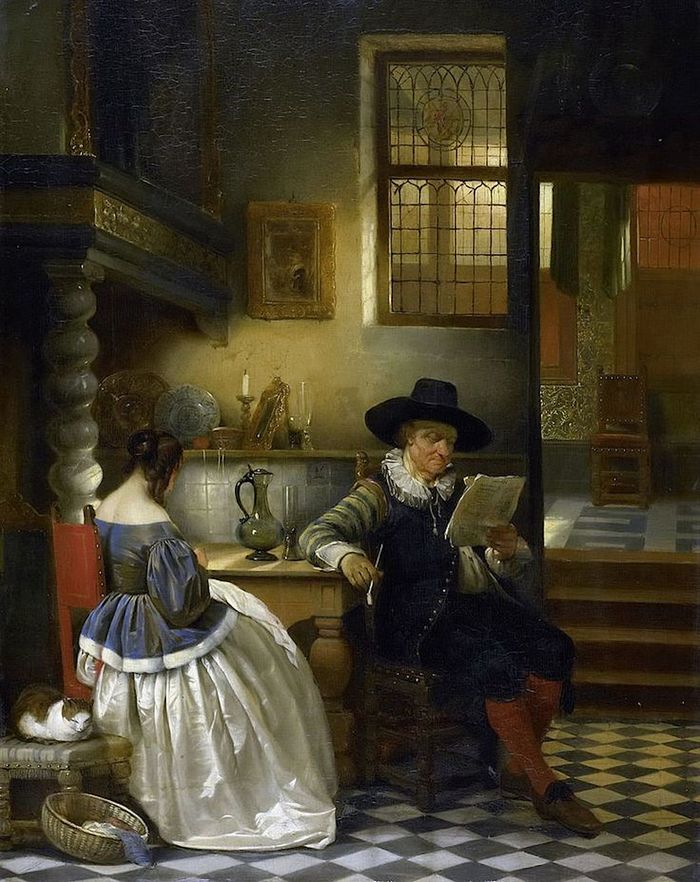
Dutch Kitchen Scene
Circa 1880
Oil on canvas
No further info
Probably private collection
(121- 1905)
Johannes Anthonie Balthasar Stroebel was a Dutch painter born in The Hague where he became a student of the art academy under Bartholomeus Johannes van Hove and his son Huib. He became a member of the Pulchri Studio in the Hague and Arti et Amicitiae in Amsterdam, and is known for genre works of interiors in the style of Pieter de Hooch. He was active in The Hague, Leiderdorp, and Renkum. He died in Leiden.
https://en.wikipedia.org/wiki/Johanne...

Dutch Kitchen Scene
Circa 1880
Oil on canvas
No further info
Probably private collection
Johannes Anthonie Balthasar Stroebel
(121- 1905)
Johannes Anthonie Balthasar Stroebel was a Dutch painter born in The Hague where he became a student of the art academy under Bartholomeus Johannes van Hove and his son Huib. He became a member of the Pulchri Studio in the Hague and Arti et Amicitiae in Amsterdam, and is known for genre works of interiors in the style of Pieter de Hooch. He was active in The Hague, Leiderdorp, and Renkum. He died in Leiden.
https://en.wikipedia.org/wiki/Johanne...

Dutch Kitchen Scene
Circa 1880
Oil on canvas
No further info
Probably private collection
(121- 1905)
Johannes Anthonie Balthasar Stroebel was a Dutch painter born in The Hague where he became a student of the art academy under Bartholomeus Johannes van Hove and his son Huib. He became a member of the Pulchri Studio in the Hague and Arti et Amicitiae in Amsterdam, and is known for genre works of interiors in the style of Pieter de Hooch. He was active in The Hague, Leiderdorp, and Renkum. He died in Leiden.
https://en.wikipedia.org/wiki/Johanne...

Dutch Kitchen Scene
Circa 1880
Oil on canvas
No further info
Probably private collection
The next and last post for this month is an artist we already encountered in the second post, it was the lady seen from the back eating some fruits.
I had about a dozen more pics to choose from, but finally decided to go for this artist's most famous painting:
Henri de Braekeleer
(1840 – 1888)
Henri Jean Augustin de Braekeleer was a Belgian painter. He was born and died in Antwerp. He was trained in drawing by his father Ferdinand de Braekeleer, a well-known genre painter, and his uncle Jan August Hendrik Leys. Braekeleer entered the Royal Academy of Fine Arts (Antwerp) in 1854. Although he remained a student there until 1861, he publicly exhibited his paintings for the first time in 1858, when Reaper and Washerwoman (locations unknown) were shown at the Antwerp Salon. In 1863, he went to Germany and, in 1864, to the Netherlands, studying works by 16th- and 17th-century painters in both countries. The influence of Johannes Vermeer was especially important, seen in one of de Braekeleer's most characteristic subjects: a single person absorbed in a quiet activity, shown in an interior lit by a window.
https://en.wikipedia.org/wiki/Henri_d...
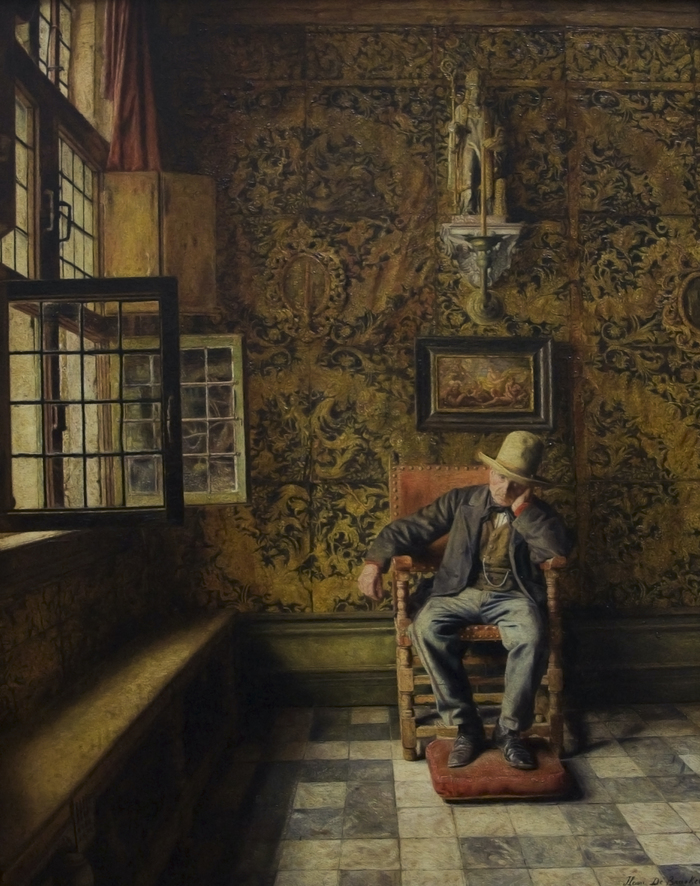
De man in de stoel (The Man in the chair)
Circa 1875
Oil on canvas
79 x 63 cm
KMSKA (Royal Museum of Fine Arts Antwerp)
https://www.kmska.be/en
https://www.kmska.be/en/collection/ar...
I had about a dozen more pics to choose from, but finally decided to go for this artist's most famous painting:
Henri de Braekeleer
(1840 – 1888)
Henri Jean Augustin de Braekeleer was a Belgian painter. He was born and died in Antwerp. He was trained in drawing by his father Ferdinand de Braekeleer, a well-known genre painter, and his uncle Jan August Hendrik Leys. Braekeleer entered the Royal Academy of Fine Arts (Antwerp) in 1854. Although he remained a student there until 1861, he publicly exhibited his paintings for the first time in 1858, when Reaper and Washerwoman (locations unknown) were shown at the Antwerp Salon. In 1863, he went to Germany and, in 1864, to the Netherlands, studying works by 16th- and 17th-century painters in both countries. The influence of Johannes Vermeer was especially important, seen in one of de Braekeleer's most characteristic subjects: a single person absorbed in a quiet activity, shown in an interior lit by a window.
https://en.wikipedia.org/wiki/Henri_d...

De man in de stoel (The Man in the chair)
Circa 1875
Oil on canvas
79 x 63 cm
KMSKA (Royal Museum of Fine Arts Antwerp)
https://www.kmska.be/en
https://www.kmska.be/en/collection/ar...





This is a copy of the original thread in the Art Lovers group.
We did this to have extra disk space to upload pictures to the group.
Every month I choose a theme and try to post as many different artists as there are days. (with the exception of last summer when I dedicated two whole months to one artist: https://www.goodreads.com/topic/show/...
I won't reveal at first what the theme is so the first days it's a bit of a guessing game. But I promise it will be not so difficult this month. More difficult will be for me to choose which painting to post, because as always I’ve selected too many!
You are welcome to comment on the pictures posted, or on other people's comments, you can say whatever you want (keeping with the rules of the group of course).
The only rule to this thread is that the person running this thread can post a picture here.
So please don't post a picture in this thread. That's all!
Enjoy!
Adolph Artz
1837 – 1890)
David Adolph Constant Artz was a 19th-century Dutch painter and collector who associated with some members of the Hague School.
https://en.wikipedia.org/wiki/Adolph_...
At the Orphanage in Katwijk-Binnen
Between circa 1870 and circa
Oil on canvas
97 x 130 cm
Rijksmuseum
https://www.rijksmuseum.nl/en/visit